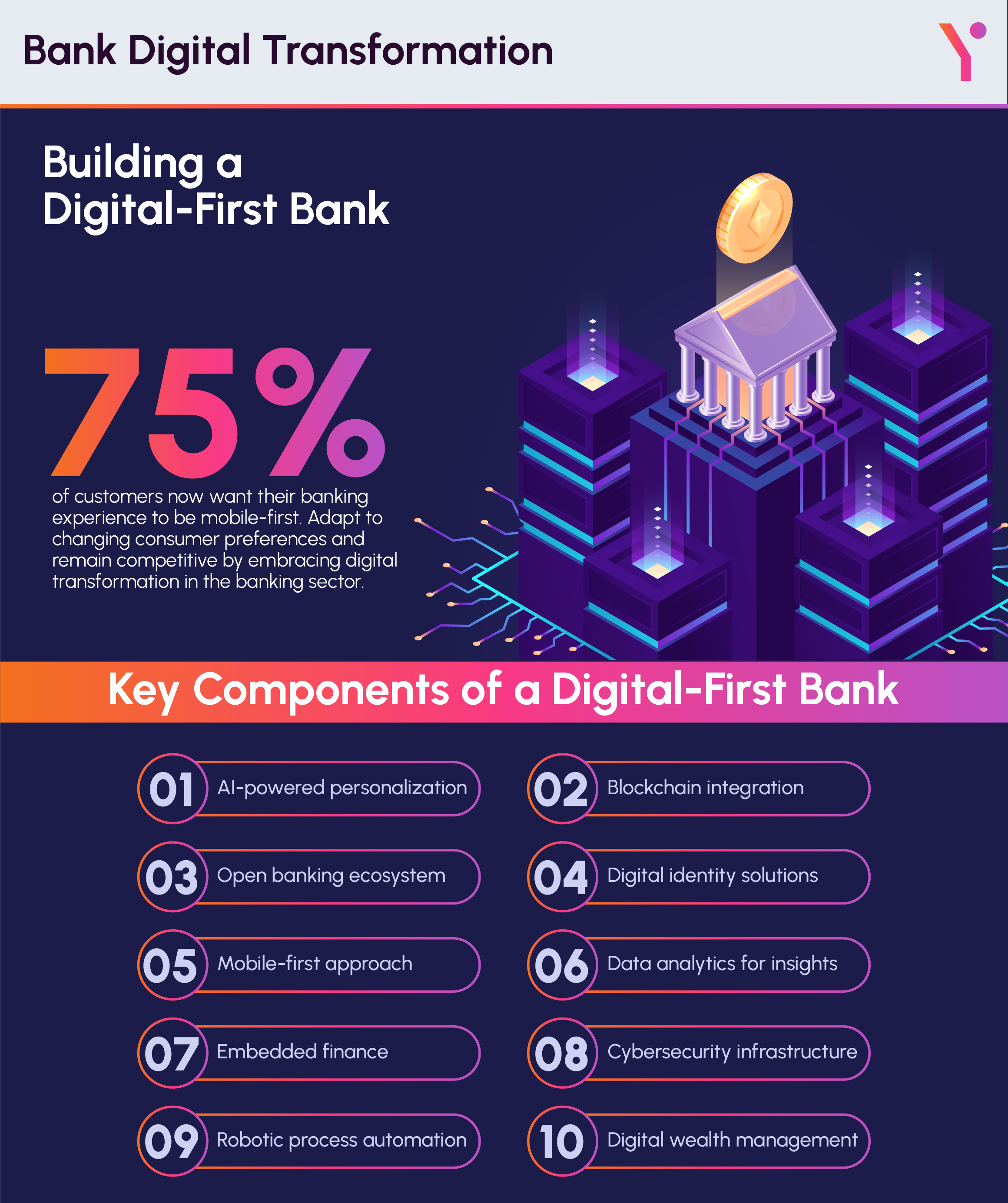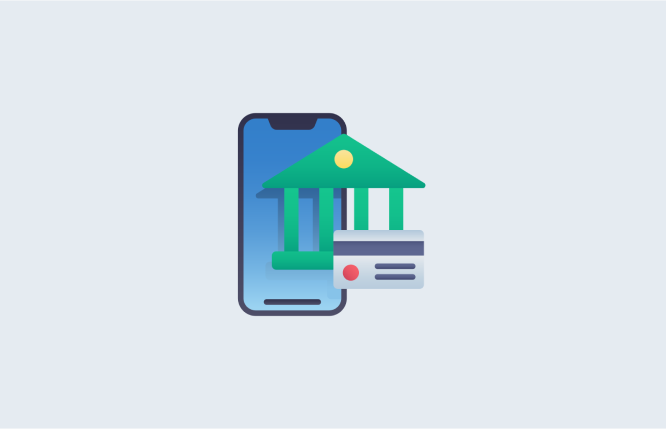Introduction
This blog explores how banks are transforming to meet customer demands for a digital-first experience. We will look at the key components of a successful digital bank, from AI-powered personalisation to robust security. Partnering with fintech experts is crucial, and we provide tips to streamline your bank’s digital transformation journey. Embrace the future – start your transformation today!
The way we bank has undergone a drastic shift. Remember visiting the local branch to deposit a check or open a new account? Today, a tap on your phone handles most banking needs. This transformation, driven by technology and changing customer behaviour, is called bank digital transformation.
Evolution of Banking Over Time
For centuries, banks have been our only leading financial systems. Initially, banking revolved around physical interactions at brick-and-mortar branches.
Then we saw the invention of ATMs, which offered some convenience, but the true transformation came with the spread of the internet.
The Internet age opened various doors for online banking of different types. We now have the power to manage accounts remotely via mobile phone. Now, mobile banking apps have become everyone’s preferred choice. All these advances came so fast, and in 2024, the trends reflect that the Bank’s Digital Transformation will make transactions faster, easier, and more accessible.
What is Meant by Digital Transformation in Banking?
Bank digital transformation is more than just online banking services. It’s a complete overhaul of how banking works. Banking is all about putting the customer at the centre by utilising modern technology to deliver a digital-first experience.
With digital banking, you can check your balance, pay bills, and even invest, all within a user-friendly mobile app. What is the core essence of a digital-first bank? A focus on convenience, speed, and a personalised experience.
Why Banks Must Embrace Digital Transformation
Here’s why digital transformation is no longer optional for banks:
Customer Demands:
Today’s customers expect a frictionless banking experience at any cost. They want mobile access to manage finances, 24/7 support, and big transactions with just a tap.
The Rise of Fintech:
Fintech startups are disrupting the financial sector with innovative software solutions. Banks that don’t go digital transformation will struggle to compete in 2024. However, to achieve digitalisation, banks must consult with software companies to leverage technology to offer faster, cheaper, and more user-friendly financial services.
Automation Through Digital Tools:
Digital tools automate many back-office tasks, freeing up resources and reducing costs. This allows banks to ultimately benefit customers.

Key Components of a Digital-First Bank
Building a successful digital-first bank requires a strategic approach that incorporates cutting-edge technologies. Here’s a breakdown of some crucial components:
AI-Powered Personalisation
People today want the banking app to be their accountant and financial advisor; that’s where AI comes in. AI may remember your spending habits and suggest budgeting tools or investment options for your financial stability. AI may also anticipate your needs and recommend relevant products and services.
Blockchain Integration
Blockchain technology, primarily known for its transactions in cryptocurrencies, has exciting applications in banking. Blockchain can streamline cross-border payments and improve transparency in record-keeping. At the same time, widespread adoption of Blockchain is still pending. Undoubtedly, integrating Blockchain can pave the way for a more secure and efficient banking future.
Open Banking Ecosystem
Open banking allows banks to securely share customer data with third-party applications, with the customer’s consent, of course! This opens a world of possibilities. Imagine a budgeting app seamlessly connecting to your bank account or a financial advisor using your data to provide personalised investment advice. Open banking fosters collaboration and innovation within the financial sector, ultimately benefiting you, the customer.
Digital Identity Solutions
Gone are the days of lengthy account verification processes. Digital identity solutions use secure technologies to verify your identity online, making onboarding and account management a breeze. This not only saves you time but also strengthens security measures.
Mobile-First Approach
Your smartphone is likely your constant companion. A digital-first bank understands this and prioritises a mobile-first approach. User-friendly mobile apps should be the cornerstone of your banking experience, allowing you to manage finances, transfer funds, and access support anytime, anywhere.
Data Analytics for Insights
The digital revolution has made data the new gold. Banks today learn a lot about their customers’ spending habits by using data analytics. Ideally, this data could potentially be utilised to enhance the consumer experience by creating targeted offerings and services and personalising marketing efforts.
Embedded Finance
For many people, having financial services smoothly integrated into their daily lives is an ideal scenario. This becomes feasible with embedded finance. You might, for instance, get a microloan when you book a trip or pay bills straight from a shopping app. As a result, managing one’s finances becomes easier and more streamlined.
Cybersecurity Infrastructure
The protection of your hard-earned money is of the utmost importance. A digital-first bank prioritises strong cybersecurity measures to safeguard your data from intrusions. You consult with the developers to integrate systems for detecting fraud, continuous security audits, and encryption technologies, which are all part of this.
Robotic Process Automation (RPA)
Data input and account reconciliation are examples of repetitive processes that can be both time-consuming and error-prone. Software robots can automate these processes through robotic process automation (RPA), allowing bank workers to concentrate on more strategic projects and intricate client interactions.
Digital Wealth Management
Investing used to be a complex process reserved for the wealthy. Digital wealth management platforms make investing more accessible. These platforms offer automated investment tools, educational resources, and personalised investment advice, all conveniently available through your mobile app.
By implementing these key components, banks can build a strong foundation for a digital-first future. Let’s now look at some pointers to keep in mind before partnering with a fintech software development company that can empower digital transformation.
Choosing the Right Banking App Development Company
In today’s digital age, a user-friendly and secure mobile banking app is no longer a luxury; it’s a necessity. As you embark on your bank’s digital transformation journey, selecting the right banking app development company becomes a critical decision. Here’s a comprehensive guide to help you navigate this process:
Define Your Needs and Goals:
Before seeking partners, take time to clearly define your bank’s specific needs and goals. What functionalities do you envision for your app? Do you want basic features like mobile banking and bill pay, or are you aiming for a more comprehensive platform with features like investment tools and budgeting assistance? Additionally, consider your target audience. Understanding their needs and preferences will influence the app’s design and functionalities.
Research and Shortlist Potential Partners:
With your goals in mind, start researching potential banking app development companies. You need a software development company with a proven track record in developing secure and successful banking applications.
Here are some key aspects to consider:
Experience:
Focus on an app development company with extensive experience in fintech software development. Check the portfolio that showcases successful projects within the banking industry.
Security Expertise:
Security is paramount. Choose a company that prioritises robust security measures and adheres to industry compliance regulations.
Technology Stack:
Ensure the company utilises a modern technology stack that aligns with your bank’s infrastructure and future scalability needs.
Development Methodology:
Understand the development process the company employs. Agile methodologies often promote flexibility and quicker turnaround times.
Communication and Transparency:
Look for a company that values clear communication and fosters a collaborative partnership.
Evaluate Proposals and References
Once you’ve shortlisted a few potential partners, request detailed proposals outlining their development approach, timelines, costs, and team composition. Don’t hesitate to ask for references. Read the case studies of clients to learn about their experience working with the company. Get to know their focus on aspects like project management, communication, and overall satisfaction.
Consider Cost and Value
While cost is a factor, it shouldn’t be the sole deciding element. Look for a company that offers a competitive price but prioritises quality and a secure development process. The best partner will deliver an app that meets your needs while staying within budget and delivering long-term value.
Tips that Will Streamline Your Bank’s Digital Transformation
The traditional banking landscape is rapidly changing. Customers now expect a seamless, digital-first experience, and institutions that fail to adapt risk falling behind. Bank digital transformation might seem overwhelming; Don’t worry. Go through key steps to create a clear roadmap for success.
1. Confront Your Technical Debt
Before building a digital future, it’s crucial to take stock of your present state. Technical debt refers to outdated systems, manual processes, and security vulnerabilities that hinder your operations. Identify areas like:
Manual Tasks:
Repetitive tasks like data entry are prime candidates for automation, freeing up employees for more strategic work.
Compliance Gaps:
Unidentified compliance issues can pose serious legal and reputational risks.
Cybersecurity Shortcomings:
Weak security measures leave your data and customers vulnerable to cyberattacks.
Sluggish Systems:
Outdated technology can lead to slow performance and frustrated customers.
Code Quality:
Poorly written code creates maintenance nightmares and hinders future development.
Legacy Frameworks:
Clinging to outdated systems limits your capabilities and adaptability.
By pinpointing your technical debt, you can prioritise improvements and create a clear action plan for tackling them.
2. Bridge the Skills Gap
Digital transformation requires a skilled workforce. Assess your IT team’s capabilities and identify any gaps in skills related to:
Emerging Technologies:
AI, Blockchain, and data analytics are shaping the future of banking.
Application Integration:
Seamless connections between internal and external systems are crucial for a smooth user experience.
Cloud Infrastructure:
Cloud-based solutions offer scalability, security, and agility.
Modernisation:
Upgrading legacy systems can unlock new possibilities and improve efficiency.
Cybersecurity Expertise:
Robust security measures are essential for protecting customer data.
Considering the current talent shortage in these areas, consider partnering with custom software development solutions companies. Partnering with these experts can bridge the skills gap and accelerate your digital transformation journey.
Book a free consultation session with Futurbyte, a leading financial technology consultancy. Our experts will assess your current banking structure, identify areas that require improvement, and develop a customised roadmap for success.
Conclusion
The traditional banking landscape is undergoing a seismic shift. Customers are demanding a seamless, digital-first experience, and banks that fail to adapt risk irrelevance.
However, digital transformation doesn’t have to be an intimidating prospect. So, following the key steps outlined in this blog may help you create a clear roadmap for success.
Remember, the heart of a successful digital transformation lies in prioritising the customer. To adopt digitalisation in the banking sector, you should make modern technologies like AI, Blockchain, and open banking your companion to personalise experiences, enhance security, and foster innovation.
Moreover, bridge any skills gaps by partnering with a web and application development company and leveraging their expertise to build a secure and scalable digital future for your bank.
The future of banking is digital, and the time to transform is now. Don’t wait until you’re left behind. Take the first step by booking a free consultation with Futurbtye, a leading financial technology consultancy.
Our team of professionals will analyse current circumstances, find ways to improve them and create a personalised plan to help you succeed in digital transformation. Let’s work together to make digital banking easy for your consumers and strengthen your bank’s future success.
Frequently Asked Questions
Absolutely! While a mobile app offers a more native experience, custom website solutions can be a great starting point for digital transformation. A modern, user-friendly website with features like online account management and bill pay can significantly improve customer experience.
Partnering with Futurbyte is crucial for navigating this challenge. We as a leading cloud consulting firm specialize in migrating legacy systems to the cloud, which offers scalability, security, and agility – all essential components for a successful digital transformation.
Not necessarily! Cross platform mobile app development allows you to build a single app codebase that functions flawlessly on both iOS and Android devices. This saves time and resources while ensuring a consistent user experience across platforms.
Have questions or feedback?
Get in touch with us and we‘l get back to you and help as soon as we can!




